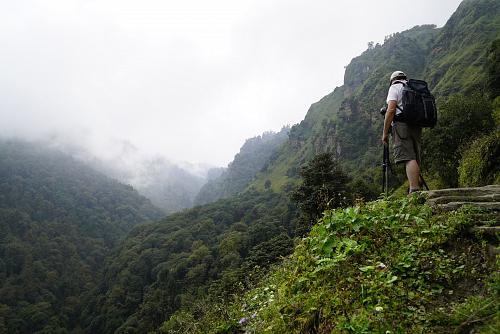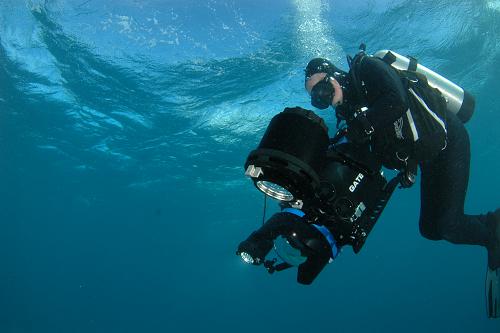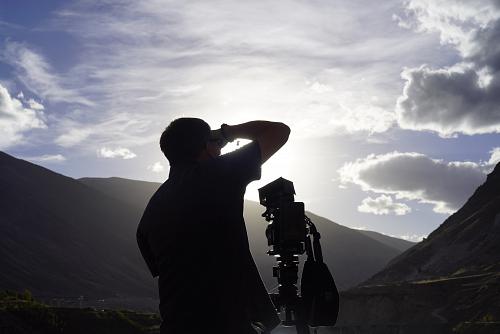- Bed
- 1 King
- 2 Kings
- 2 Queens
- 2 Doubles
- Price per Night
- Below $100
- $100 to $200
- $200 to $300
- $300 or more
- Smoking
- Smoking
- Non-Smoking
- Accessibility
- Hearing Impaired
- Roll-In Shower
- Bathtub with Bars
- Room Size
- Small
- Medium
- Large
Already have a reservation? Manage Reservation
Windows of the World: Peppermill's Resort Art

What was once started as a hobby by Joe Ness, Peppermill’s Executive Director of Entertainment, Electronics, and Media (EEM), has become a mini-industry with more than $25 million investment and more than half a dozen full-time employees. Currently, the EEM team has visited all seven continents and more than 30 countries to gather footage for the Peppermill Resort properties.
Ness gives us insights into how Windows of the World came to be, his travels, and what the future holds.
How did you get into photography and videography?
I’ve always loved cameras, but never really pursued a career in photography. It’s always been more of hobby, more of a passion. I was living in Los Angeles when I worked for MTV and borrowed a video camera from my roommate that I’d take to Venice Beach to record sunsets. I’d lock the shots down and get great landscapes that moved.
For the next few years I continued to have small cameras and shoot that way. After having kids, I was the “video dad,” creating videos from Christmas morning that I’d completely edit and add full sound to. I bought a Sony medium-level HD camera and would hike alone, letting the images come to me. I went into this venture to create a library of videos for myself, but it’s become so much more.
How did you start doing video work for the Peppermill?
I moved back to Nevada and owned an audio/visual contracting business that primarily designed and built large A/V systems for venues like casinos and football stadiums. Our largest client at the time was the Peppermill. We’d installed stereos and screens that displayed music videos all over the resort.
I had been taking a low-quality HD camera to Pyramid Lake to get some killer shots of the clouds and the water lapping across the shore. I got home and rotated my TV vertically to display the images and thought it looked really cool and different. I ended up bringing it into my office where Bill Paganetti, the Peppermill’s co-owner, saw it. He asked me what it was and I said it was a personal art project, which he thought was cool. He left, and came back five minutes later to see it again and ask what it would take to put a couple of these art screens in the Peppermill’s lobby.
How did you go about creating the content for the first digital art screens?
I let Bill know that in order to do this correctly, we needed enough video for the content to repeat and not get old, and a way of playing the video other that just hitting play on a camcorder. So, he gave me a decent budget and 90 days. I went all around California – Yosemite, Big Sur, Death Valley – and ended up getting over 1,000 images.
I hired a guy from L.A. who knew servers and how to get the best playback with good video quality, and we figured out the process and the software. After a lot of late nights, we made the 90-day deadline and installed two TVs in the front desk registration area.
What was the reception to this new art?
We had a huge response from guests and employees, and the rest is history. I’ll never forget, literally right after we put the TVs in the registration area, Bill thought it would be a great idea to get tropical footage for our Barracuda Beach area. A friend suggested going to St. Barts in the Caribbean.
I was 41 years old at the time and had never traveled outside the country – I didn’t even have a passport. It was going to take two weeks to get one and we had a deadline to install new panoramic screens, so I drove to San Francisco to get the passport and flew to the Caribbean the next day. I flew out and got great shots by myself. I couldn’t even believe this was really happening.
What was your first Windows of the World trip?
Our first trip with a big crew was to Antarctica. It was a real eye-opener into the logistics of shooting abroad. We had to get permits, take multiple planes, and figure out how to carry cameras and get these cameras in great locations in the best light. I made a lot of early mistakes and put the team in stressful positions that they probably didn’t need to be in. Sometimes, we would hike for long distances without the right backpack equipment and come back with basically broken shoulders. I push people to their limit; I’m on adrenaline the whole time.
To get to Antarctica, we had to take a boat through Drake Passage, which is known for being one of the bumpiest sea voyages with crazy consistencies. We took Dramamine and tried to sleep through two days of sailing. When I woke up and got out of the cabin, I went on deck before we de-embarked. It was completely calm and silent, with just the hum of the motor. And I saw the most beautiful sight – snow-covered mountains and icebergs just passing along smoothly.
What types of equipment do you use?
We shoot with the highest quality cameras. We started shooting with a 4K camera about 12 years ago when the Red Digital Cinema camera company came out with Red One camera. From there, we graduated to using 5K and 6K Red Epic and Red Dragon cameras. We recently acquired two Red Weapon cameras, which are 8K and have the highest dynamic range of any camera available. In the last two years, we’ve installed the highest quality display screens available with resolution and dynamic range to match the cameras. This helps us create an unprecedented visual experience for our guests.
The ability to send our high-definition video signals throughout the Peppermill Resort properties requires a huge investment in cables, networking, and server technology. Maintaining the equipment to play everything requires a 24/7 staff of trained techs who know how to keep everything up-and-running.
Peppermill’s ownership has never wavered on investing what it takes to get this right, and as new technology is developed, we are using it right away to make our photography more impactful.
Tell us about your team and what they bring to the table.
We have the best team in the business assembled for what we do. Photographers Chris Bentzen and Joe Kukler have been on the team for over 10 years. Not only are they amazing photographers, but they help with the logistics of planning the trips and know how to deal with the stresses of travel with carrying the equipment and dealing with all the unknowns. Sara Waugh is a film school graduate and a relative newcomer to our crew. She brings a fresh approach to the team and has opened our eyes to new ways of doing things. She’ll be traveling with us on our next trip.
How do you plan and prepare for your trips?
We try to focus on finding non-tourist locations that are off the beaten path. We usually make arrangements ourselves and find guides when we need to, which gives us more flexibility.
After we decide on the location, we start mapping out highlights or locations that would work well for our type of photography. We pre-visualize the trip on Google Earth and map locations before we make any travel arrangements. In Google Earth, you can zoom in on an area and find actual points where we’d want to set up the tripods. It also offers great panorama photos of exact GPS locations. In Ireland, there was a great little spot four miles off the main road that we found on Google Earth. It was the coolest bay with crashing waves and a big medieval castle in the background. No one would really notice the spot because they’d be exploring the castle, but the best shot was really found off the road.
What goes through your mind when you’re shooting a landscape?
When I shoot scenery, I try to capture moments in time that, to me, are a window of what Earth looks like at that particular time. Trillions of those moments happen every day – from a little sand crab poking its head out of the sand and running to the water to a wonderfully contrasting cloud throwing shadows across a beautiful mountain. That moment only lasts for 20 seconds before the cloud covers the mountain and the shot is completely dead. The best part of this world is these moments of light, when the world exposes the best of what it has to offer to my lens. These moments are fleeting and hard to find, but being able to anticipate and recognize those moments are what makes the magic in these images.
What’s the scariest thing you’ve encountered during your travels?
When you travel and do this type of work, you put yourself in a certain amount of risk. We’ve put ourselves in precarious situations like filming sharks and climbing glaciers in the Patagonia with harnesses and getting tied off to get the edge of crevasses on glaciers.
Working in the wild with animals that are within touching distance can be intense. We traveled to the mountains of Rwanda to photograph the wild silverback gorillas. We hiked through the hot and humid climate up the steep mountains on the equator, while a team of guys with machetes cut holes in bamboo to get to the location. I was nervous because we only had an hour with these creatures, and paid over $100,000 for the trip, including $50,000 in permits.
We set up our cameras and start filming, but the small gorillas were shy and evasive, and all we saw were rear ends. I didn’t know how I was going to tell the co-owner of the Peppermill that he spent $100,000 to photograph the rear of a gorilla. Just then, I saw a big gorilla with a bunch of green forest in front of his face chewing on bamboo, but I couldn’t get a clear shot. I said to myself, “If only he would move the branches from his face and expose himself, I’d have a great shot.” I hit record, got the focus, and two seconds later he spread his hands to expose his face and looked right at the camera with curious eyes.
For the rest of the time there, I swear the gorillas posed for me. Instead of walking away, they approached the cameras and posed with humanistic mannerisms that touched my heart. When we were leaving, a large gorilla, supposedly the biggest and oldest in the population, buzzed right through us and hit Bentzen. Right there, the shoot went from a warm and cozy moment to one of absolute fear.
How do you create your underwater videos?
We’ve developed a process where we put tripods underwater to shoot virtual aquarium images. We use Chris Bentzen, who is a professional diver, along with hiring some of the best divers in the world to help us get this footage.
We start with a pre-dive to get an idea of locations, and then the crew and I draw up a plan on a dry erase board. Then we drop the tripod to our underwater photographers, who all have communication with each other and the boat. I can direct the entire photo shoot on the boat deck with an HD monitor. Safety is always our biggest concern, and we work very closely with the boat captain, who also monitors the air levels.
Tell us about a rewarding experience that has resulted from your work.
In addition to the Windows of the World video art, we take snapshots from the videos to frame and display throughout all the properties. I was asked by the maître d' of The Steak House at Western Village if we could sell one of the photos displayed in the restaurant. I told her that we don’t sell them, but I was in the process of printing pictures anyway and would make a copy. I told her to give me a call the next time the family came in so I could give it to them and sign a copy. The next time they came in, I met with an older man and his three grown children. The man asked me to sit down for a second and tell them the story behind this picture. I remember that it was a full moon rise, and there was a bank of clouds on the horizon. As it was rising, it was going through clouds at dusk and displaying beautiful orange and purple colors. While this was happening, I was getting bombarded by mosquitos. The crew was in the van, but I wanted to get this shot, so I stayed out with my long lens.
The man told me that his wife had passed away 12 years ago, and they were married for almost 50 years. Every full moon, the couple would go to the mountains to watch the moon rise. When the man saw the picture of the clouds that were rolling over the moon in the picture, it reminded him of her red, flowing hair. When I mentioned the mosquitoes, he told me that his wife hated mosquitos and it had been a big thing their whole life. I told him that wherever his wife was, there weren’t mosquitos. We both cried.
You’ve been to all seven continents. What has been your favorite trip so far and why?
My favorite trip so far was my time in the Far East when the team visited Tibet, Nepal, and India. It was truly life-changing for me. A van dropped us off in the foothills of the Himalayas, and we trekked up the mountains for five days. We stayed at tea houses, woke up at 4 a.m. to climb to the tops of lookouts, and saw some of the most amazing vistas in the world. All of the trips allow me to look at myself and the world in a different way – not only being able to travel to these areas, but by immersing ourselves into local cultures and working with local people who help with our travel and pursuit. You really realize that we are one world.
What’s next for the team?
We’re in the beginning stages of planning a trip to Portugal and Spain. We’ll be going everywhere from the countryside of Portugal, to Madrid, Lisbon, all the way up through the mountains of the Basque area of northern Spain, and, of course, to the ancient city of Barcelona.
Why do you think your job is the best job in the world?
Being able to bring back these images for so many people to enjoy in such a great environment makes this the greatest job. Having the ability to travel, and even sometimes get to travel with my family. This photography has given me a new look on the world and people. I hope that these images capture that, because we are one big world and it’s beautiful.

